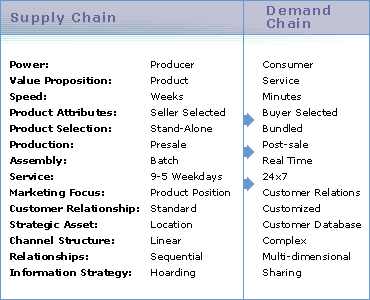Shifting Supply Chain to the Demand Chain

How does a Company shift the Supply Chain to the Demand Chain
Shifting the supply chain to the demand chain is a strategic move that many businesses are undertaking to better align their operations with market requirements. The primary objective is to transition from a traditional 'push' model, where products are produced and pushed into the market, to a 'pull' model, which is dictated by real-time consumer demand. This shift relies heavily on eBusiness architectural drivers and can be facilitated through several steps:
To conclude, shifting from a supply chain to a demand chain model is not a simple task. It involves a significant overhaul of existing business processes and IT infrastructure. However, by leveraging eBusiness architectural drivers, companies can make this shift more effectively and efficiently, enabling them to be more responsive to market demand, reduce costs, and improve customer satisfaction.
- Customer-centric approach: The cornerstone of a demand chain model is a deep understanding of the customer. Companies need to leverage tools and techniques like Customer Relationship Management (CRM) systems, customer segmentation, and personalized marketing to accurately gauge customer preferences, behavior, and demand patterns.
- Real-time data analytics: Transitioning to a demand chain model requires a robust infrastructure for real-time data analytics. Businesses need to deploy advanced analytics and AI tools to analyze customer data in real-time, gaining insights into current demand trends, predicting future demand, and responding proactively to changes in the marketplace.
- Digital Transformation: Companies must embrace digital transformation to facilitate real-time data sharing and seamless integration across different business functions. The digital transformation should encompass all facets of the organization, from procurement and production to sales and distribution, enabling companies to respond swiftly to changes in demand.
- Supply Chain Visibility: Achieving complete supply chain visibility is crucial in a demand chain model. Companies need to invest in technologies like Internet of Things (IoT), blockchain, and cloud computing to enable real-time tracking of products throughout the supply chain, facilitating more agile and responsive decision-making.
- Flexible Production and Inventory Management: To meet fluctuating demand, businesses need to adopt flexible production strategies and just-in-time inventory management. These strategies can be enabled by technologies like additive manufacturing (3D printing), and smart warehousing, which allow businesses to produce and stock products based on current demand levels.
- Omnichannel Strategy: In a demand chain model, an omnichannel approach is paramount. Businesses need to ensure a seamless customer experience across all touchpoints, be it physical stores, online platforms, or mobile apps. They must integrate their channels, both online and offline, using technologies like APIs and microservices, to provide customers with a unified shopping experience.
- Strategic Partnerships and Collaborations: Collaborating with suppliers, logistics providers, and even competitors can enable businesses to be more responsive to market demand. Businesses need to establish strategic partnerships based on mutual trust and shared objectives, facilitated by technologies like blockchain and smart contracts, to ensure efficient and transparent collaboration.
To conclude, shifting from a supply chain to a demand chain model is not a simple task. It involves a significant overhaul of existing business processes and IT infrastructure. However, by leveraging eBusiness architectural drivers, companies can make this shift more effectively and efficiently, enabling them to be more responsive to market demand, reduce costs, and improve customer satisfaction.
Workflow management
Workflow management systems support the dynamic definition, execution, monitoring, and modification of business processes.
All sorts of processes like opening a bank account, managing a supply chain, or hiring a new employee can be automated.
Process control is separated from core business logic (such as a financial portfolio investment strategy, or accounting rules) and from data.
This permits flexible adaptation of rapidly changing business processes without having to touch the other elements of the IT system.
Workflow management systems are well suited to integrate existing legacy applications into new business processes.
Leading workflow management systems are, for instance IBM's FlowMark, FileNet, and extensions of groupware system such as
Lotus Notes Prozess Ware. Although the concept offers striking advantages, pure workflow management solutions have had only limited success in specialized application areas. More frequently, package vendors such as SAP, PeopleSoft, Oracle, Siebel, or Ariba have integrated workflow concepts and engines into their prepackaged offerings, using the workflow component to permit custom-specific tailoring of their packages.
Workflow management systems are typically used to send documents managed by a document management system through the organization. They are particularly well suited to support highly structured business processes. If the workflow is of an ad hoc nature, groupware and messaging systems are used.
Competitive Landscape